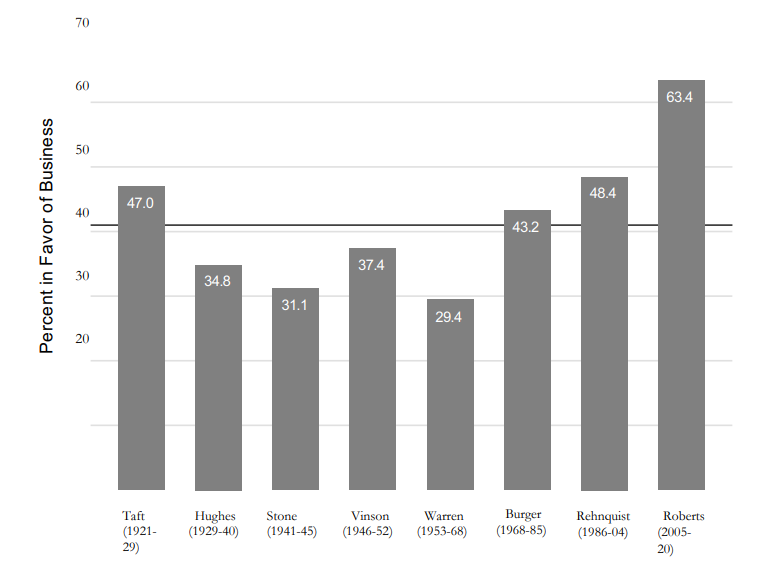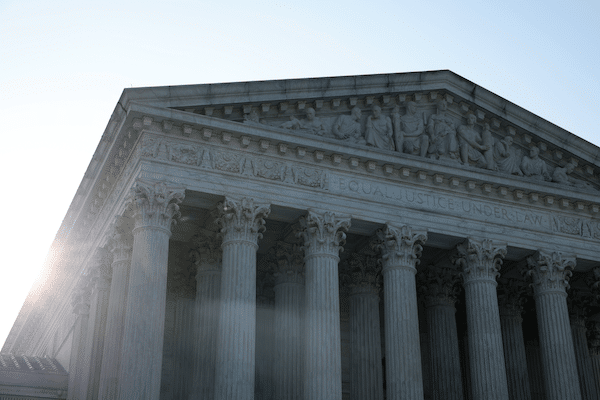President Calvin Coolidge, in a January 1925 speech to newspaper editors, asserted that “the chief business of the American people is business.” The claim, although far from true, did capture the short-lived success of business leaders in structuring the country’s social institutions for the benefit of the wealthy.
Tragically, we appear well into another period when business needs and desires are promoted as consistent with American values and enshrined into law. The pro-business orientation of the current Roberts Supreme Court highlights this reality. As Lee Epstein and Mitu Gulati show in their paper “A Century of Business in the Supreme Court, 1920-2020”:
the Roberts Court may be the most pro-business Court in a century. The win rate for business in the Roberts Court, 63.4 percent, is 15 percentage points higher than the next highest rate of business wins over the past century.
The data
The authors use the Supreme Court Database, considered to be the definitive source on the Supreme Court and its decisions, for their study; it includes material on cases from the 1791 Supreme Court term through the 2020 Supreme Court term. For the years 1920-2020, the focus of their work, the authors found 11,121 orally argued cases that resulted in a signed opinion or judgment by the court. A business was a named party on one side or both sides in 43 percent of those cases. Removing cases when both parties were businesses left 37 percent of the decided cases, or 4,070 cases. These were the cases Epstein and Gulati used to examine the business orientation of the Supreme Court.
The record
Epstein and Gulati found that businesses won 41 percent of their cases over the entire 100-year period of their study, 1920-2020. But as illustrated in the figure below, the business success rate has been on the rise. Each period in the figure is represented by the name of the Court’s presiding Chief Justice. As we can see, the business success rate hit a low of 29.4 percent during the Warren years and then began to climb, with a big jump to 63.4 percent during the current Roberts Court.

The Taft Court held the record as the most business friendly court for decades, and it was well-earned. Its dockets were dominated by business, whether on one side or both. Over its 9 terms, approximately 60 percent of its cases involved business. And as the authors note,
the Taft Court also invalidated more laws ‘than in fifty years preceding’—most of which were attempts by government to rein in business.
The business share of cases, at 40 percent, has been far lower during the Roberts Court era. But the Roberts Court stands out as “the first Court in the last 100 years that rules in favor of business more often than not” when considering a case where business is opposed by a nonbusiness entity or individual. A business win rate of 63.4 percent is quite an accomplishment.
But that win rate is only the average over the Court’s many terms. A term-by-term examination reveals that the Roberts Court is becoming ever more business friendly. As the authors point out:
For the first six terms, the rate of business wins was 53 percent (2005), 63 percent (2006), 47 percent (2007), 44 percent (2008), 44 percent (2009) and 62 percent (2010). And it is worth remembering that this was a period during which the Roberts Court was already being labeled as “business friendly.” For the next ten terms, the numbers are higher: 73 percent (2011), 69 percent (2012), 65 percent (2013), 68 percent (2014), 71 percent (2015), 79 percent (2016), 69 percent (2017), 65 percent (2018), 70 percent (2019) and 83 percent (2020). The highest percentage of business wins in the first six terms (63 percent) is lower than the lowest percentage in the next ten terms (65 percent).
TThe Roberts Court’s record of support for business is certainly noteworthy. It appears to have easily earned the title of the most pro-business Court in a century.
What’s going on?
The authors consider four explanations for the business-friendly orientation of the Supreme Court, especially during the Roberts Court: The justices’ partisanship, reduced government activism, more experienced corporate counsels, and public opinion. In terms of partisanship, their own work, as well as that of others, establishes that Republican appointed judges are more likely to favor business than Democratic appointed judges. For example, their regression results show “that Republican appointees are about 7 percentage points more likely to vote in favor of business than Democrats—a statistically significant difference.”
But that result masks a more striking political development. As we see in the next figure, while Republican appointees on the Roberts Court voted in favor of business at a far higher rate than Republican appointees in previous Courts, Democratic appointees on the Roberts Court are also far more favorable to business than Democratic appointees in previous courts. In fact, these Democratic appointees voted on the side of business in 50 percent of the cases, a higher percentage of pro-business votes than Republicans made during all previous Court eras except one. In other words, the Supreme Court’s embrace of business cannot be explained simply by party labels; both Republican and Democratic leaders are selecting business friendly justices.

The authors also found evidence suggesting that a drop-off in federal legal interventions and more experienced corporate legal representation help to explain the high and rising business success rate. For example, the success rate for business is far lower when the federal government—specifically, the Office of the Solicitor General (OSG)—is its opponent. However, the percentage of business cases in which the OSG is also a party has been dramatically falling, from over 50 percent during the Stone and Vinson Courts to a low of 20.5 percent during the Roberts Court. In other words, the federal government appears less interested in challenging cases involving business. As for expert corporate counsel, the authors found that lawyers with past experience before the Court appear have a higher success rate than first-timers and business has significantly increased its use of more experienced lawyers.
Public opinion definitely cannot explain the Court’s pro-business trend. Multiple polls and surveys show declining confidence in, and support for, business by self-identified Republicans, Democrats, and independents. Thus, it is hard to make the case that the pro-business trend in Supreme Court decisions is a response to a rising tide of business approval by the public.
What next?
The Taft Court era likely shows the trajectory of the Roberts Court. The Taft Court justified its pro-business rulings with doctrines that fit its ideological orientation. One example was its use of the so-called Lochner doctrine, which drew its name from a 1905 case, Lochner v. New York. In that case, the court struck down a New York statute that forbid employment in a bakery for more than 60 hours per week and 10 hours per day, arguing that the regulation interfered with the right of contract between the employer and employee. In other words, starting from the idea that society should be organized by market forces, the Taft Court found it appropriate to rule against social regulations that interfered with individuals negotiating their own work-related contracts, and this included minimum wage laws and child labor restrictions as well as maximum hour regulations.
As Samuel Bagenstos, the author of an Economic Policy Institute study on labor law and workplace power explains:
The Lochner-era cases were based on an abstract, formalist understanding of bargaining between employers and workers. The idea, which judges often made explicit, was that absent labor legislation employers and workers were each equally free to enter into, or refuse to enter into, contracts with each other. That is, the courts presumed that employers and employees had equal power in the labor market. Protective labor laws disrupted that natural baseline of contractual freedom by barring both sides of the transaction from entering into bargains that they would otherwise prefer to make.
It is quite easy to imagine the Roberts Court seizing on a similar Lochner-era understanding to challenge many of the social regulations won by working people after years, if not decades, of struggle. It is this kind of process that helps business remake America for business.
So, where does that leave us? With life-time appointments, we are faced with a pro-business Court for years. Moreover, given the increasingly pro-business orientation of Democratic appointees to the Supreme Court, we cannot expect relief down the road simply from voting for Democratic politicians. At present it seems we have little choice but to raise a ruckus and do our best to help people understand that the Court is no objective interpreter of existing laws; rather, it actively constructs the law according to its own political vision. And, as we have seen, the Roberts Court has been among the most aggressive in promoting business interests. However, if public anger and class awareness grows sufficiently, the Court may well be forced to stay its hand.

